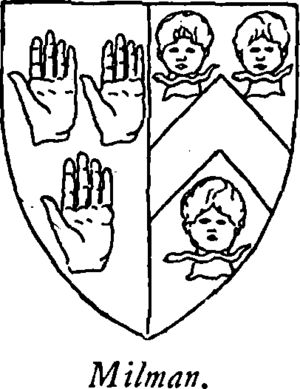William Milman (lawyer) facts for kids
Quick facts for kids
Sir William Milman
|
|
|---|---|
| Born | c. 1650 |
| Died | 3 February 1713 (aged 62–63) |
Sir William Milman (1650–1713) was an English lawyer who argued cases in court. He was made a knight in 1705. This happened after he was introduced to Queen Anne by the Earl of Dorset.
Contents
Who Was Sir William Milman?
Sir William Milman was born in London around 1650. He was baptized at St Martin-in-the-Fields on January 9, 1650. His parents were William Milman and Mary Palmer. His father, William Milman the elder, first worked as a shoemaker. Later, he ran a coffeehouse.
How Sir William Became a Knight
Milman became very wealthy by dealing in stocks. For most of his life, he worked as a lawyer in London's Inns of Court. He was so good at his job that he became friends with the Earl of Dorset. The Earl of Dorset was an important person. He introduced Milman to Prince William's mother, Queen Anne. Because of this important connection, Milman was made a knight on February 7, 1705. The special ceremony took place at St James's Palace.
Sir William's Family Life
Sir William Milman was married three times during his life.
- His first wife was Elizabeth Taylor. They had two children, but sadly, both died when they were babies. One of their children, Ann Milman, was born in 1677.
- Later, William married Laetitia Masters. She was the widow of Samuel Masters, a preacher. Laetitia and William did not have any children together. She was buried in 1702.
- Milman's third and last wife was Elizabeth Vaughan. She was from Wales. They also did not have any children.
His Final Years and Legacy
Sir William Milman died on February 3, 1713. He did not have any children who survived him. He left most of his large fortune, which was about £20,000, to his nieces. These were the daughters of his brother, John Milman. His nieces, Elizabeth, Robella, Mary, and Diana, each received a share of his money. There was one condition: they and their future families had to keep the Milman last name.
Sir William's mother, Mary Milman, also survived him. She was given the house she lived in and £100 every year. His widow, Lady Elizabeth, was in charge of his will. She received £600 every year, as long as she did not remarry after Sir William's death.
Sir William was buried at More's Chapel in Chelsea. This chapel used to belong to Thomas Moore. Sir William owned it after he bought Gorges House. His tombstone shows his family's coat of arms. It says he was a knight and a lawyer who died at his house in Chelsea on February 3, 1713, at 64 years old.
Milman House and Street
After Sir William died, his former home was named Milman House. This estate was originally called Gorges House. Sir William bought it from a dancing teacher named Josias Priest. Sir William likely took ownership of the property around 1711.
After Sir William's death, Milman House went to his four nieces. By 1726, the house was torn down. His nieces then rented out the land. New buildings were put up there and were planned to be called "Milman's Row." Today, a street called Milman's Street still exists in the area. This street is a reminder of Sir William Milman's connection to the neighborhood.
Family History and Coat of Arms
Sir William Milman's family, the Milmans of Levaton-in-Woodland in Devon, were also settled in Holderness, Yorkshire, and Chelsea. Some stories say the family came from Johannes de Malamanus. He was a Norman officer who came to England with William the Conqueror. Johannes was sent to stop a rebellion in 1070.
The name 'Malamanus' means 'bad-hand.' This name came from Johannes being left-handed. This is why the Milman family's coat of arms has three left-handed gloves, called sinister gauntlets.
The Milman Coat of Arms
The Milman family's coat of arms is described as: "Azure, 3 sinister gauntlets argent (Milman)." This means it has a blue background with three silver left-handed gloves. It also includes the Vaughan family's arms: "sable, a cheveron between 3 boys' heads with adders about their necks (Vaughan)." This part has a black background with a V-shape and three boys' heads with snakes around their necks.


